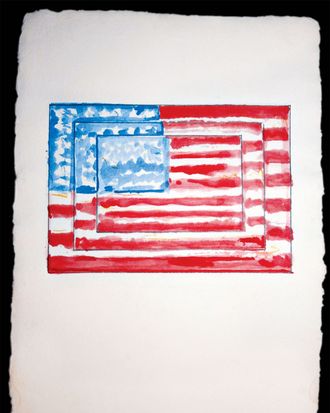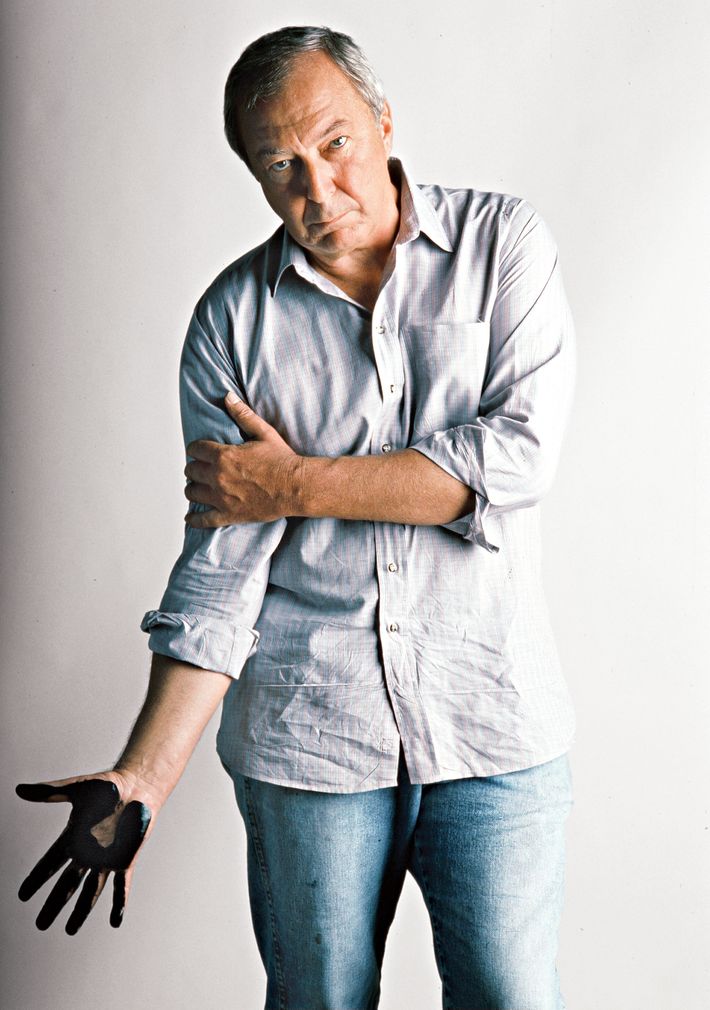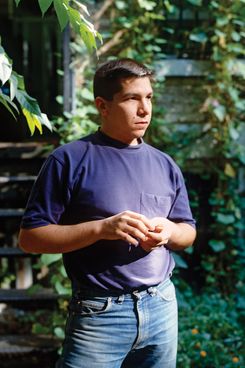
In his half-century as one of the universally sanctified titans of modern art, Jasper Johns has led a private life, if not a reclusive one, shuttling between his homes in Connecticut and St. Martin with a circle of friends who are protective of him and guarded on his behalf. ÔÇ£HeÔÇÖs spent his whole life cultivating a certain air of mystery,ÔÇØ says David Ross, a friend of the artist and the former director of the Whitney. Those who still see him say Johns, now 84, can be a brilliant, charming presence, but also by turns slightly cool and prickly ÔÇö the counter┬¡weight, in temperament, of his ┬¡vivacious late friend and partner Robert Rauschenberg. Another friend compares him to fellow introverts like Philip Roth and Philip Glass: superficially polite yet diffidentÔÇöand, at moments, abrupt and even biting. The work comes first, and they work alone.
JohnsÔÇÖs primary studio ÔÇö a large, fully renovated old barn on the grounds of his 130-acre estate in Sharon, Connecticut ÔÇö is a reflection of his personality. There is no Jeff KoonsÔÇôlike army of implementers doing his bidding and no Andy WarholÔÇôlike Factory of hangers-on in the corners, watching it all happen. He only occasionally allows visitors; the few assistants heÔÇÖs employed are meant to recede into the background, there but not there. It was in Sharon that one friend, the art dealer Francis Naumann, first met JohnsÔÇÖs longtime studio assistant James Meyer.
Given how withdrawn Meyer was around Johns, itÔÇÖs a little remarkable that Naumann managed to get to know him at all. Stocky and mostly silent, Meyer seemed mainly to be on hand to help Johns move things around in the studio; he would join them for lunch, too, but rarely took part in the conversation and almost never shared an opinion. After a number of visits, Meyer let Naumann know that he, too, was an artist. ÔÇ£He was painting a little like Jasper,ÔÇØ the art dealer remembers, ÔÇ£though, of course, he was completely unknown.ÔÇØ When he learned that Meyer had dyslexia and had difficulty writing the personal statements and other literature that an artist needs to be noticed by gallery owners and dealers, Naumann offered to help. ÔÇ£Every once in a while he would send me something that he wrote, and I would try to put it into better English.ÔÇØ
NaumannÔÇÖs next brush with Meyer ÔÇö the important one ÔÇö took place in the spring of 2009. Naumann was contacted by a fellow art dealer named Fred Dorfman, asking if he knew of any collectors in the market for a small work by Jasper Johns, a 12-by-14-inch black-and-white drawing on plastic ÔÇö ÔÇ£a complete and fully finished, beautiful drawingÔÇØ signed by Johns, Naumann says. Dorfman emailed a photo of the drawing to Naumann, who then sent it to a client of his, a New JerseyÔÇôbased collector named Frank Kolodny, who fell in love with it. Soon after, Naumann learned that the person selling the drawing was Meyer. On the face of it, he insists, the news that JohnsÔÇÖs longtime studio assistant was unloading one of his bossÔÇÖs works struck him as only slightly peculiar. Artists like Meyer ÔÇ£always need money at one time or another,ÔÇØ Naumann says.
Given everything thatÔÇÖs happened since, itÔÇÖs not surprising that Naumann sounds a little defensive when he tells the rest of the story. It made sense at the time, he says, that Meyer would, over the years, have received at least one of JohnsÔÇÖs works as a present. In fact, Naumann had once seen a Johns drawing not so different from this one hanging above the fireplace in the home of Sarah Taggart, JohnsÔÇÖs secretary. It also made sense, Naumann says, when he learned that Meyer had set two conditions on the transaction: The sale could not be public, and the buyer could not resell the drawing for eight years. ÔÇ£You canÔÇÖt go tell the artist, ÔÇÿIÔÇÖm selling the drawing you gave me,ÔÇÖÔÇëÔÇØ Naumann says. ÔÇ£It might make it a little bit uncomfortable if heÔÇÖs still working for the guy.ÔÇØ
They agreed on a sale price: $400,000. Naumann says he conducted the appropriate due diligence. He negotiated for Kolodny to be allowed to break the eight-year sale restriction if Meyer stopped working for Johns for any reason. He had Dorfman send him a copy of an official record kept in JohnsÔÇÖs office, verifying the work was a gift to Meyer. And he got a sworn affidavit from Meyer himself saying the work was authentic, heÔÇÖd owned it since 1995, and he had the authority to sell it.
What he didnÔÇÖt do, however, was pick up the phone to try to discuss the sale with Johns. Better, he thought, to be discreet ÔÇö and sensitive to the studio assistant who was parting with an artistic treasure he no doubt had witnessed the master create. For the same reason, he says, he never spoke with Meyer. This couldnÔÇÖt have been an easy decision for the man. Why rub it in?
It would be another three years before Naumann, along with everyone else, would learn the truth ÔÇö that the page from JohnsÔÇÖs ledger was a complete forgery; that the drawing, though a genuine artwork by Jasper Johns, never belonged to Meyer; that Meyer had covertly pulled it from a file drawer in JohnsÔÇÖs studio; and that thereÔÇÖd been a lot more where that came from.
Johns was only 27 when he became a darling of the art world. The Museum of Modern Art snapped up three of his works at his first solo exhibition at the Leo Castelli Gallery in 1958. Pushing past Abstract Expressionism, Johns brought in tantalizing figurative elements ÔÇö flags, targets, numbers, letters. In the early years, working out of a loft studio downtown, Johns, awash in money and attention, had thrived on the creative foursome he forged with Rauschenberg, John Cage, and Merce Cunningham. As heÔÇÖs gotten older, JohnsÔÇÖs circle has narrowed while, among collectors, his work has remained as precious as platinum. In 1980, the Whitney paid $1 million for Three Flags (1958), a record price for a living artist at the time. In 2006, Citadel hedge-fund founder Kenneth Griffin bought False Start (1959) from media mogul David Geffen for $80 million, setting a record.
To continue to produce work at that level demands a great deal of help, and practically no artist of JohnsÔÇÖs caliber gets by without a staff of paid assistants maintaining the studio, cataloguing work, and handling the paperwork for sales and authentication. ItÔÇÖs a relationship that demands a great deal of trust, and Johns was perhaps particularly trusting. Gary Stephan, one of JohnsÔÇÖs first assistants, says he named his own salary, which Johns paid without discussion. ÔÇ£He was very happy to just let things happen. It was like that Cage thing, allowing for chance.ÔÇØ Stephan remembers being charged with disposing of large sections of a huge artwork Johns was making for the 1967 WorldÔÇÖs Fair. ÔÇ£I could have easily outstretched the canvas and walked out the door with it. But I didnÔÇÖt.ÔÇØ
Meyer began working for Johns in 1985, starting when he was just 22. He grew up in suburban Northport, Long Island, a boy of Mexican ancestry adopted by white middle-class parents. MeyerÔÇÖs father sold insurance. Neither his father nor his mother understood art or knew what to make of their sonÔÇÖs interest in it. He started painting in earnest at 17, producing prints and showing them in Northport. Though Meyer has not commented to the media since being accused, he has shared his story in interviews in the past, even arranging for a friend to interview him for a long Q&A on his own promotional website. ÔÇ£I was fearless,ÔÇØ he said. ÔÇ£It never occurred to me to be shy about my art.ÔÇØ
At the School of Visual Arts, where he enrolled in 1980, he was, in his own words, ÔÇ£finally asked to leave because I would hand in whatever I was working on and pay no attention to the assignment.ÔÇØ Deciding ÔÇ£I knew what I wanted to make,ÔÇØ Meyer lived cheap, couch-surfing in the city. His work was included in exhibitions at Danceteria, the New Museum, and the Pat Hearn Gallery. In search of a regular job, he made some slides of his work and knocked on the doors of the studios of Rauschenberg, Roy Lichtenstein, Frank Stella, Richard Artschwager, and Jasper Johns. Most of the studios werenÔÇÖt open, but an assistant was there at JohnsÔÇÖs, and he left his slides. When he came back for them the next day, Johns was there. ÔÇ£Two hours later,ÔÇØ Meyer recalled, ÔÇ£he hired me.ÔÇØ
From that point onward, MeyerÔÇÖs ambitions and tastes were subsumed to those of Johns. When Johns moved to Sharon in the ÔÇÖ90s, Meyer and his wife, Amy Jenkins, followed, to a cheaper town nearby called Lakeville. At the estate in Sharon, Meyer worked four days a week, Tuesday through Friday, and lived close enough to come by and help Johns if he needed anything in the studio over the weekend. Each winter, Meyer would come down to JohnsÔÇÖs home in St. Martin just long enough to set Johns up for the season, then leave. All the while, Meyer kept waking up early in the mornings ÔÇö 5 a.m., heÔÇÖd say ÔÇö to make art of ÔÇ£the rich bed of images, banal as they sometimes are, that sometimes keep me awake at night.ÔÇØ Suburbia dominated MeyerÔÇÖs art: a girl playing with a hula hoop, a boy jumping over a fence. The figures were often in silhouette, with candy-colored patterns behind them. ÔÇ£TheyÔÇÖre pretty crudely rendered and serially rendered,ÔÇØ says one gallery owner who has shown MeyerÔÇÖs work, ÔÇ£which I think was a direct influence of JasperÔÇÖs, using the same image over and over again.ÔÇØ
MeyerÔÇÖs descriptions of his art told the story of being unnoticed, of observing others, and of a deep, unchecked insecurity. In one show, he cited the influence of DostoyevskyÔÇÖs Notes From Underground. ÔÇ£There is this man narrating his story, trying to be something and always failing, and always blaming other people for his poor behavior,ÔÇØ he said at the time. ÔÇ£So he watches the world from his silent perch. I canÔÇÖt help but be like that in a way.ÔÇØ A year later, he mounted a show in which his work focused on windows, explaining their appeal as ÔÇ£a removed situation where you can remain unseen.ÔÇØ
Northwestern Connecticut has its share of cultural elites like Johns, among them David Whitney and Agnes Gund. Meyer became a visible and endearing presence in a different, more workaday circle of hopeful artists. Together with Jenkins, a teacher at the Indian Mountain School, Meyer helped found the Art Garage, a 2,000-square-foot art studio that hosted an after-school art program at Housatonic Valley Regional High School. He mounted fund-raisers for the Art Garage and solicited donations of artwork to be sold there. Johns donated at least once. But the creative side of Meyer never was part of his daily working life. Meyer once told a friend that any lines he drew on JohnsÔÇÖs canvases would eventually be erased and redrawn by the master. (One friend of JohnsÔÇÖs says itÔÇÖs preposterous for Meyer even to have suggested that Johns would have let him draw lines on his work in the first place.)
Meyer cycled through galleries in Connecticut and New York, never finding the right launchpad. His networking in the art world had a sharp, disingenuous edge to it. ÔÇ£Once he even gave me a work of art out of the blue,ÔÇØ says one major art critic. ÔÇ£I was so freaked out I returned it to his dealer, saying, ÔÇÿI donÔÇÖt accept anything.ÔÇÖÔÇëÔÇëÔÇØ Another art writer, John Yau, who visited Johns a few times, had a similar experience. ÔÇ£I had mixed feelings about him. I never felt I wanted to cross any lines. He wanted to get a gallery and dealers. He was rather aggressive about it. I felt there was a kind of attitude that he had, so I kept my distance.ÔÇØ
After a while, Meyer became known as abrasive, on the make, creepy even. The artist Laurie Simmons, who has a place with her husband, the artist Carroll ┬¡Dunham, in northwestern Connecticut, remembers the email blasts sheÔÇÖd get from Meyer over the years. ÔÇ£ThatÔÇÖs not uncommon,ÔÇØ she says. But she recalls one time getting a fund-raising email from Jenkins, and then a follow-up from Meyer that began ÔÇ£My friend, Amy Jenkins, has been trying to get in touch with you ÔǪÔÇØ
ÔÇ£I thought, That is so odd,ÔÇØ Simmons says. ÔÇ£ÔÇëÔÇÿMy friendÔÇÖ?ÔÇØ SheÔÇÖd never call her husband her friend, even in an email. ÔÇ£A really odd disassociation thing to do.ÔÇØ
What set Meyer off most, it seemed, was rejection. ÔÇ£He took his work very seriously and himself very seriously, a little over-the-top,ÔÇØ one gallery owner says. When this gallery dropped Meyer, ÔÇ£it was taken personally,ÔÇØ he says, and ÔÇ£the reaction was way out of line.ÔÇØ Jenkins even called to complain.
His lack of success, however, didnÔÇÖt stop them from living well. Around 2007, Meyer, Jenkins, and their two children moved from their shingled Cape-style house on a bustling street in Lakeville to a more remote mid-century-modern home in Salisbury, once the home of the cartoonist Robert Osborn. They never sold the Lakeville house, and they rented the Osborn house. There were other conspicuous purchases ÔÇö four cars, two motorcycles, three trailers, a 42-foot fiberglass sailboat ÔÇö at the same time that MeyerÔÇÖs children were approaching college age (one has graduated from NYU, and the other attends SVA). A few others in JohnsÔÇÖs close orbit now say theyÔÇÖd noticed Meyer was living high. ÔÇ£I think they tried to draw it to JasperÔÇÖs attention,ÔÇØ Naumann says. ÔÇ£But then Jasper maybe concluded heÔÇÖs doing well selling his work. Because what did he know?ÔÇØ

In February 2012, word trickled out around Sharon and Lakeville that Jim Meyer wasnÔÇÖt working for Jasper Johns anymore. It didnÔÇÖt take long for MeyerÔÇÖs friends in the local art community to hear the reason, though the details were vague. ÔÇ£Someone emailed an image to check against the catalogue raisonn├®, and it got back to Jasper,ÔÇØ one friend of MeyerÔÇÖs says. Johns ÔÇ£knew immediately it was not something he permitted. Jim was fired that day.ÔÇØ
Naumann was shocked, he says, and puzzled. The artwork that exposed Meyer was not the drawing that Naumann had helped his client Kolodny buy. Naumann spent more than a week unsure of what to do. Finally, he says, Johns called him and politely asked Naumann to tell his lawyer everything he knew about what had happened. Naumann, relieved, said heÔÇÖd be happy to. During that call, Johns said something that astonished him: Meyer had mailed Johns back one of the stolen drawings. Naumann told Johns that he hoped he kept it in its original paper. ÔÇ£If somebody mailed back a drawing, isnÔÇÖt that a clear acknowledgment that you were the thief? IsnÔÇÖt that, like, admitting to it immediately?ÔÇØ
For 18 months, Meyer and his family proceeded as if nothing were wrong, at least outwardly. Meyer mounted two different exhibitions of his own artÔÇöat the Hotchkiss School and Gering & L├│pez on Fifth Avenue. Meanwhile, he quietly transferred ownership of the Lakeville house to AmyÔÇÖs name. When the indictment was finally unsealed in August 2013, Meyer stood accused of stealing 22 artworks, some unfinished, between 2006 and 2012. They all apparently had come from the same drawer in JohnsÔÇÖs studio, a drawer Meyer maintained. Meyer was said to have created fictitious inventory numbers for the pieces ÔÇö and, for certain sales like KolodnyÔÇÖs, fake pages in the ledger book. The pieces brought in $6.5 million, with Meyer pocketing $3.4 million.
After a year of negotiation with the U.S. AttorneyÔÇÖs office, Meyer pleaded guilty in August, agreeing to pay back nearly $4 million, or about $600,000 more than what he is said to have earned from the sale of the works. At his December 10 sentencing, he could get a prison sentence of as long as ten years. Since Meyer never stood trial, his motivation remains speculative. ÔÇ£The assistantÔÇÖs probably sitting there,ÔÇØ one friend of JohnsÔÇÖs says, ÔÇ£thinking each brushstroke is a thousand dollars.ÔÇØ
Dorfman, who orchestrated the deals for Meyer, avoided prosecution. But in May of this year, he was pulled into the case by a civil suit filed by Kolodny, claiming in court papers that Dorfman ÔÇ£conspired with Meyer to perpetrate this elaborate fraud.ÔÇØ The lawsuit argues that Dorfman could not possibly have believed that Johns had generously gifted artwork valued at $6.5 million. In October, KolodnyÔÇÖs lawyer, Judd Grossman, amended the suit, alleging that Meyer and Dorfman had colluded to steal not 22 but ÔÇ£nearly 50ÔÇØ artworks by Johns ÔÇö including the work at the top of this story ÔÇö and that Dorfman had kept them not in his gallery but at home. DorfmanÔÇÖs lawyer, Adam Mitzner, says that his client would never knowingly sell stolen art and that ÔÇ£James Meyer defrauded many people, including Fred Dorfman.ÔÇØ
Naumann and Kolodny arenÔÇÖt facing prosecution. The U.S. Attorney apparently considers them to be victims of the swindle, like Johns. And the buyers of MeyerÔÇÖs 21 other stolen Jasper Johns artworks? ÔÇ£Whether theyÔÇÖre exposed criminally, theyÔÇÖre probably already on the governmentÔÇÖs radar,ÔÇØ Grossman says. ÔÇ£We have people come to us all the time saying, ÔÇÿOh, IÔÇÖve got this great deal on this work. The workÔÇÖs got a bit of a sketchy provenance, but itÔÇÖs worth the investment.ÔÇÖ Which is why I think you donÔÇÖt see a flood of litigation following this disclosure.ÔÇØ

When Naumann thinks of Meyer now, he remembers perhaps the one time when he saw his more vulnerable side. Grateful for NaumannÔÇÖs help in rewriting the notes to his shows, Meyer repaid him with a drawing heÔÇÖd made. Naumann later used the cardboard the gift came with as a base to cut something without remembering that the drawing was inside. ÔÇ£I cut his drawing in half,ÔÇØ Naumann recalls. Slightly abashed, Naumann decided he had to tell Meyer what had happened.
Meyer was livid. ÔÇ£How did you not know my drawing was in there?ÔÇØ Meyer said.
ÔÇ£I mean, maybe I should have been a little more empathetic,ÔÇØ Naumann says. ÔÇ£It just came as a surprise, you know? ItÔÇÖs not like I cut up a Jasper Johns. I cut up a James Meyer.ÔÇØ
Naumann hasnÔÇÖt spoken with Johns since that phone call in early 2012. The dealer spent most of the call concerned that what had happened would hurt their friendship. When he tried to tell Johns how bad he felt, Johns surprised him by saying, ÔÇ£You feel bad? Imagine how bad I feel. I got duped.ÔÇØ
Earlier this year, Johns unveiled a new series of paintings and works on paper, mainly in gray tones ÔÇö all variations on an image of a man sitting and holding his head sadly. The words REGRETS, JASPER JOHNS are stamped on each piece ÔÇö a coy reference to the stamp Johns has used for years to decline various invitations and offers.
Asked by a Financial Times reporter if there was any meaning to be gleaned from the fact that he started the series just after he discovered being swindled by the man whoÔÇÖd been helping him create his art for 27 years, Johns brought down the curtain.
ÔÇ£I donÔÇÖt want to talk about it. I donÔÇÖt want to define it in any way,ÔÇØ he said. ÔÇ£Regrets belong to everybody, donÔÇÖt they?ÔÇØ
*This article appears in the November 17, 2014 issue of New York Magazine.
*The original version of this article incorrectly referred to the town of Lakeville as Lakewood in one instance.


